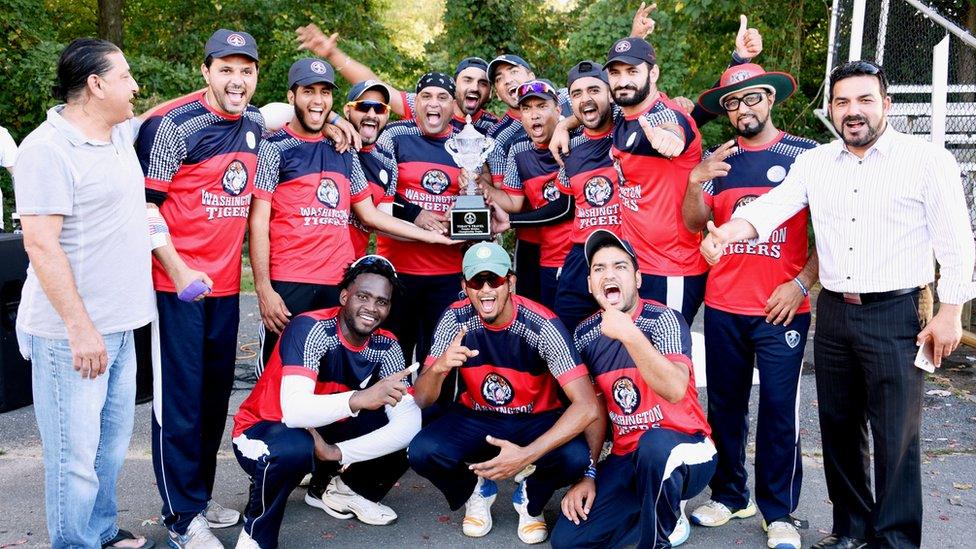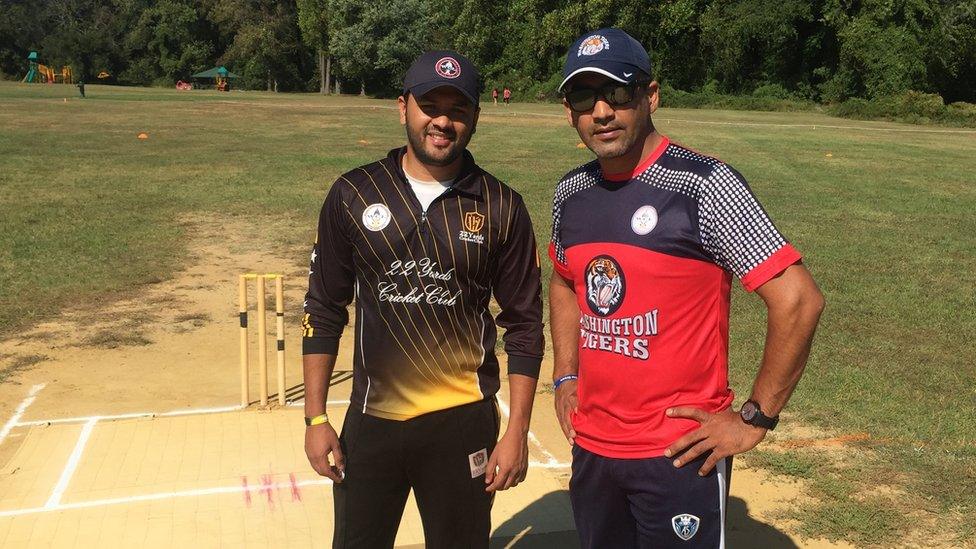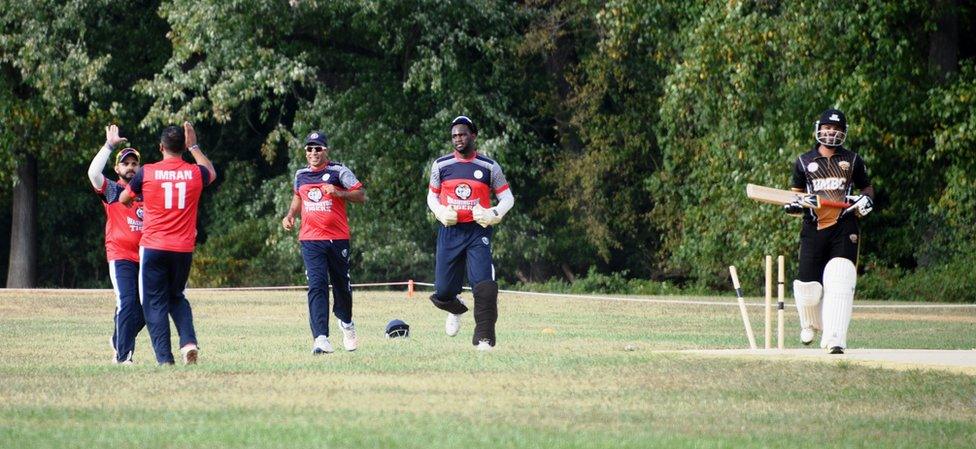American cricket gets ready for take-off
- Published

One of the world's most popular sports is barely known in the US. But, driven by a new generation of immigrants, could cricket finally take off?
It is a hot, sunny day in Hyattsville, Maryland.
Young men play basketball in the park. Barbecue smoke hangs in the hazy, late-summer air.
A cyclist rides past with the Stars and Stripes on his trailer. And then, through the trees, comes a most un-American sound.
"Howzat!"

Rikin Parikh, 22 Yards captain, with Imran Awan
Imran Awan was 17 when he moved from Pakistan to the US in 1997. He didn't think Americans played cricket but he brought his equipment, just in case.
He soon needed it.
A day after arriving, Imran played his first game on American soil, for a family friend's team. Within two years he was picked for the US national side.
Imran represented his new country in matches around the world - from Abu Dhabi to Nepal - and, aged 38, still plays locally. On this hot day in Hyattsville, he's captain of the Washington Tigers.
The Tigers are in the final of the Washington Cricket League Twenty 20 tournament, premier division. With the first and second division finals also taking place, it's a big day.
Banners hang from the bleachers. Supporters gather in the shade. Two commentators sit behind a camera, broadcasting the games live across the internet.
Imran is a bowler and his side is batting, so he stands on the sideline, waiting for his chance. In his youth, he bowled at 90 miles per hour. Has he still got it?
"I try," he says, smiling. "I try."

Teams that play Test (top-level) cricket
England; Australia; South Africa; West Indies; New Zealand; India; Pakistan; Sri Lanka; Zimbabwe; Bangladesh; Afghanistan*; Ireland*
(Recently admitted, yet to play a Test)

The Washington Cricket League, external is thriving. There are 42 teams in total, and new applicants are turned away each year because of a lack of pitches.
Another local league, the Washington Metropolitan Cricket Board, external, has 18 clubs. For an area with barely any "real" pitches, it's astonishing.
Most grounds are hired from schools or counties. Today's game is played on a matting wicket: when the game finishes, the matting is pulled up, and the field reverts to more "American" sports.
Anand Patel is a 31-year-old engineering professor at Cecil College in Maryland. He moved from Gujarat in India to study at the University of Maryland, Baltimore County, in 2007.
He started playing for his college side - "the cricket team was actually one of the reasons I picked the school," he says - and now plays for 22 Yards, Washington Tigers' opponents in the final.
"When I arrived, it was hard to get cricket equipment," he says. "We were buying online, importing from India, or going to New York where they might have a vendor.
"Now, just in the state of Maryland you have at least five or six vendors."

The increase in cricket's popularity has followed a rise in immigration from the sub-continent.
In 2000, the Indian immigrant population in the US was just over one million, according to the Migration Policy Institute, external. By 2015, it was 2.4 million.
That sub-continental influence is clear in the Washington Cricket League. Ram Ragoo, 73 and from Trinidad, has been involved since the league began in the 1960s.
Back then - aside from the embassy teams - "most of the league was West Indian", he says. Among them was Keith Mitchell, who studied in Washington and is now the prime minister of Grenada.
"Keith was the president of the league in 1981," says Ram, smiling. "Really nice guy. But Reagan sent him to Grenada after the overthrow (in 1983)."
Ram, who brims with Caribbean charisma, says the league reflects the changing face of immigration.
"The Indians came in, Pakistanis came in, the Sri Lankans started coming in, and the West Indians started to go out," he says.
"The young West Indians didn't want to play cricket. They got 400 or 500 dollars to go and play a soccer game."
In the premier division final, most players have a sub-continental background, but other cricket-playing nations are represented.
Derick Narine, the Tigers' left-handed opener, is from Guyana, as is teammate Christopher Vantull. For 22 Yards, Johan de Wet is a South African who moved to the US this summer to be with his wife.
"I arrived just before the 4 July weekend," he says. "That weekend there was a big Twenty 20 tournament, I saw 22 Yards had organised it, so I gave the guys a call.
"I played my first game probably within two weeks."
What did the wife make of it?
"She is Indian so she gets it," says Johan, laughing.
In a further example of cricket's global reach, WCL side Vikings recently renamed itself. It is now the Afghan Cricket Club of USA.
While the Washington Cricket League is certainly cosmopolitan, one thing is missing: Americans from non-cricket backgrounds.
"When we were in school, once in a while you would get an American guy showing up for practice," says Anand Patel.
"But it's hard to get used to cricket. For them to learn how to bowl or bat is difficult, even if they've played baseball. In baseball you don't bounce the ball - here you bounce the ball."
Ram Ragoo agrees. "I only know one or two born Americans who play the game," he says.
"The ICC (International Cricket Council) is trying to create (university) scholarships to get American kids involved."
For now, though, American cricket remains an immigrant-driven sport. As the big-hitting Narine scores another six, bhangra blasts out across this small corner of Maryland.

Ram Ragoo and Anand Patel
Helped by Narine's 71 in 39 balls, the Tigers are impressive, reaching 163-8 in their 20 overs. In reply, 22 Yards start well - nine runs from the first five deliveries - before a certain 38-year-old gets involved.
Imran Awan - the Tigers captain who moved to America aged 17 - dismissed Shahid Hanif for 8. He takes another wicket in his next over and 22 Yards end up 80 all out.
Imran, certainly, has still got it.
The Tigers take the title, the trophy is lifted, and another cricket memory is made in this most unlikely place. It won't be the last.